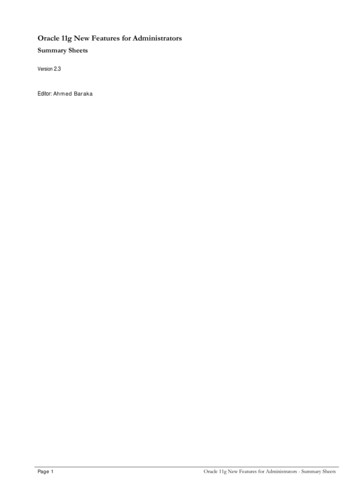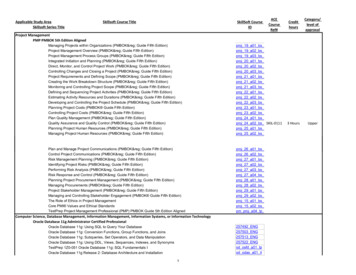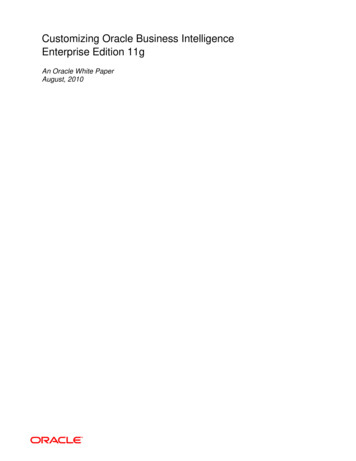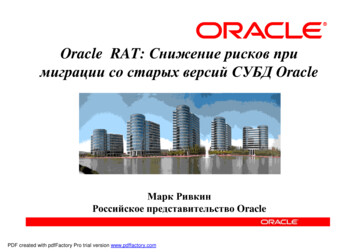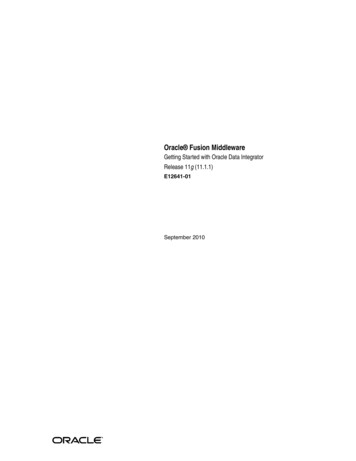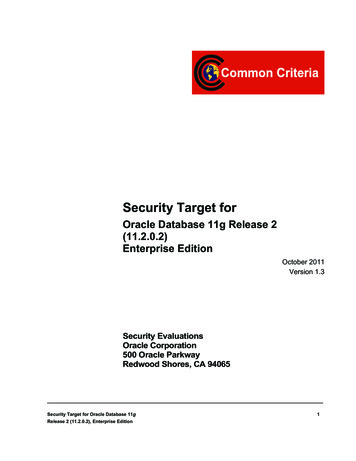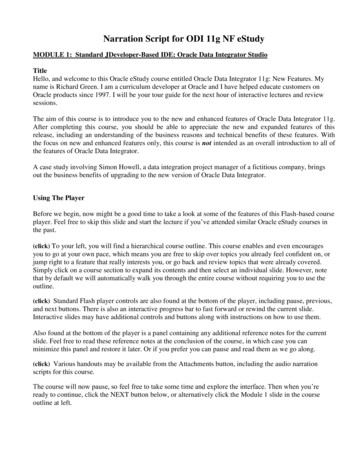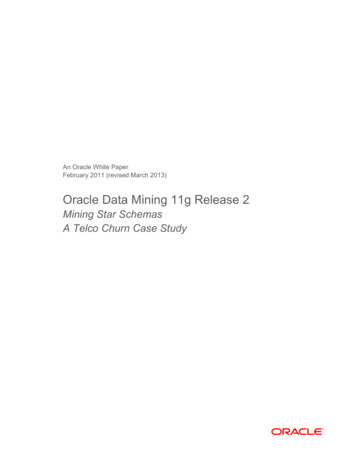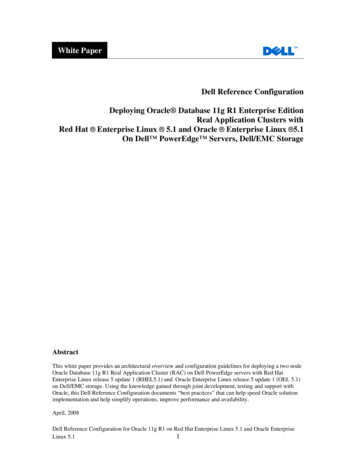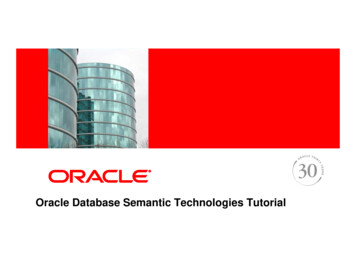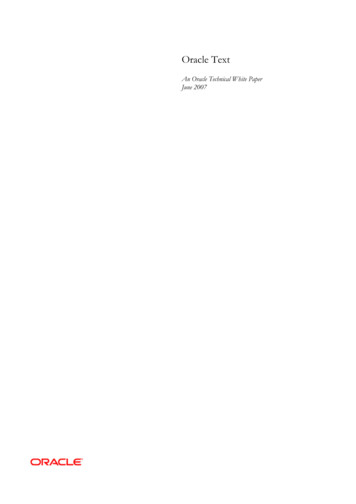
Transcription
Oracle TextAn Oracle Technical White PaperJune 2007
NOTE:The following is intended to outline our general product direction. It is intendedfor information purposes only, and may not be incorporated into any contract. It isnot a commitment to deliver any material, code, or functionality, and should notbe relied upon in making purchasing decisions. The development, release, andtiming of any features or functionality described for Oracle’s products remains atthe sole discretion of Oracle.Oracle TextPage 2
Oracle TextIntroduction.4Text is Everywhere .4Oracle Text .5Architecture.6Datastore.6Default Datastore .7File Datastore .7URL Datastore.7User Defined Datastore.7Filter.7Sectioner.7Lexer.8Lexer Preferences .8Language Specific Functionality.8Western Languages.8Multi-Byte Languages .9Indexing Engine.9Benefits of Integrated Text Search Capability .9Oracle Text Features .10Index Types .10Substring and Prefix indexes.11Maintaining Indexes and Synchronization.3Parallel Indexing .3Locally Partioned Indexes .4Query Operators.4Internationalization .6Document Services.7Highlighting.7Markup .7Snippet.8Theme Extraction.8Gist Generation .8Advanced Features .8Classification and Clustering.8Knowledge Base .10Using Oracle Text .10Creating Indexes with Oracle Text .10Oracle TextPage 3
Optimizer Hints.12XML Support .13Searching for content and structure in XML documents.15Oracle Secure Enterprise Search.16What’s new in Oracle Text 11g? .16Performance .16Minimization of application downtime .16Internationalization .16Ease of Maintenance .17INTRODUCTIONOracle Text, Oracle‘s integrated full-text retrieval technology, is part of theOracle11g Standard and Enterprise Editions. Oracle Text uses standard SQL toindex, search, and analyze text and documents stored in the Oracle database, infiles, and on the Web. Oracle Text can perform linguistic analysis on documents;search text using a variety of strategies including keyword searching, contextualqueries, Boolean operations, pattern matching, mixed thematic queries,HTML/XML section searching, etc. Oracle Text excels at mixed queries, i.e. thosethat involve structured relational attributes as well as text.Oracle Text can render search results in various formats including unformattedtext, HTML with term highlighting, and original document format. Oracle Textsupports multiple languages and uses advanced relevance-ranking technology toimprove search quality.Text is EverywhereOver the last decade, organizations have invested heavily in systems that enablerapid access to structured data stored in database systems. However, this datarepresents a fraction of all corporate information. A far larger volume exists as text- in documents, web pages, manuals, reports, email, faxes, and presentations. Thesevaluable sources of business information are often inaccessible and not managed ina cost-effective manner. Users accessing organization information - whether theyare employees visiting an intranet portal or buyers browsing a catalog - needsophisticated support from text search infrastructure to find what they want.Oracle TextPage 4
Text is underutilized in many organizations. Text assets are no longer static,physical entities. Current technology allows companies to create globallyinterconnected systems that store text information drawn from many sources.Important text assets may be hidden because it's difficult to find them. Poor searchquality is expensive.Unlocking the value of an organization‘s textual information has been a long termchallenge. Historically, text has been seen to require a different set of technologiesfor retrieval and management than other business data. This misperception hasburdened organizations with multiple storage and retrieval systems, and alsomultiple development environments. This has stood in the way of effectivelyintegrating all of the corporation’s information assets. As a legacy of thismisperception, many companies today buy different products for solving their textsearching needs and their structured data (database) searching needs. Not only isthis approach costly over the lifecycle of purchasing, integrating, operating andmaintaining different products, but it also results in poor performance and a highlatency in development of applications. Further, purveyors of specialty servers canseldom deliver the high reliability, throughput and multi-platform scalability of anenterprise database. What if it were possible to extend the power and advantagesof relational database systems to all corporate information, including text and otherunstructured data? After all, text data is real data that warrants the infrastructure ofa real database and proven tools for application development. In this white paper,we look at such an approach in the form of Oracle Text.ORACLE TEXTOracle Text offers a complete text search solution. Oracle Text is included withboth the Oracle11g Standard and Enterprise Editions. For users of an Oracledatabase, Oracle Text eliminates the need to buy and integrate a different Textsearching product.Oracle Text provides specialized text indexes for traditional full text retrievalapplications œ such as - website searching, e-business catalogs, documentclassification and routing applications, text warehousing, document libraries andarchives.Oracle Text can filter and extract content from different document formats. Itsupports a large number of document formats including popular ones like theMicrosoft Office file formats, the Adobe PDF family of formats, HTML andXML.Oracle Text offers the best multilingual set of features in the market - supportingsearch across documents in western languages (English, French, Spanish, German,etc.), Japanese, Korean, Traditional and Simplified Chinese.As part of Oracle11g, Oracle Text transparently integrates with and benefits from anumber of key enterprise features such as Data partitioning (for higher throughput and availability)Oracle TextPage 5
Real application clustering or parallel server (for the highest serverscalability) Automatic query optimization Tools and development environments Administration and manageability Integrated securityThese aspects of integration are also greatly beneficial to system administrators,who do not have to undergo a paradigm shift to learn to manage andorganization’s text assets. Oracle Text is a core piece of other Oracle products likeOracle Application Server Portal, Oracle E-Business Suite, Oracle eXchange,Oracle Secure Enterprise Search, and Oracle Content Database.All of the search capabilities of Oracle’s own internal and external web sites arepowered by Secure Enterprise Search, which uses Oracle Text as its core searchtechnology.ArchitectureThis section looks at the mechanism for processing text with Oracle Text. Thisprocess can be considered as a pipeline (Figure 1). This section discusses eachstage, and considers some of the options available at that stageFigure 1: Indexing ArchitectureDatastoreThe datastore defines from where the text to be indexed should be fetched.Provided datastores allow for text which is stored within a database, on a filesystem, or accessed remotely via the HTTP protocol (the URL datastore). CustomOracle TextPage 6
datastores may be defined which fetch the data from a location, protocol orapplication of the customer’s choice.Default DatastoreThe default datastore is in the database itself. Text may be stored in a VARCHAR2column (up to 4000 characters), or in a CLOB (Character Large Object) column.Formatted text (such as Word or PDF documents) can be stored in BLOB (BinaryLarge Object) columns.File DatastoreText to be indexed is stored on any file system which is accessible to the databaseserver. The name or path to the file is stored in the database, typically in aVARCHAR2 column.URL DatastoreThe database contains an HTTP protocol URL, and the text to be indexed isfetched directly from the URL at indexing time.User Defined DatastoreA PL/SQL procedure is specified, which will be called for each row in the tablebeing indexed. The PL/SQL procedure may, in turn, call other language programssuch as Java (directly, if running in the database) or C/C programs via theEXTPROC external procedures mechanism. This gives the customer completecontrol over what gets indexed.FilterThe filter stage is responsible for processing “formatted” documents such asMicrosoft Office files or PDF documents. The built-in AUTO FILTERrecognizes all common document formats and can translate them into indexableHTML text.Application developers may replace the filter stage with their own custom-builtfilter, or a filter purchased from a third-party.A custom filter is simply an executable program or script that takes two arguments,the first being the file containing the formatted input text, and the second beingthe name of the file where the filtered output should be written. If required, acustom filter can call the standard —autorecognize“ filter. This allows it to processany file formats unique to the business, but pass on any standard file formats to thestandard filter.SectionerThe sectioner object is responsible for identifying the containing section(s) foreach text unit. Typically, these sections will be predefined HyperText MarkupLanguage (HTML) or eXtensible Markup Language (XML) sections. Optionally,the sectioner can process all tags as sections delimiters. For example:Oracle TextPage 7
TITLE XML Handbook /TITLE . This allows search between tags using theWITHIN operator. Use of the WITHIN is illustrated in the section on XMLsearching.LexerThe lexer's job is to separate the sectioner's output into words or tokens. In thesimplest case for a Western European language, the lexer just splits text intouninterrupted strings of alphanumeric characters. So the string:Aha! It's the 5:15 train, coming here now!would be split into the words, minus any punctuation or special symbols:aha it s the 5 15 train coming here nowThe lexer typically removes stopwords, which are common words defined by theapplication developer; or taken from a default list. That would likely reduce thelist above to:aha * * * 5 15 train coming * nowNote the asterisks representing removed stopwords. Although they are not actuallyindexed, the presence of a stopword at the position is noted in the index. In asearch, any stopword will match that word when used as part of a phrase. Forexample, “kicking the ball” will match “kicking a ball” but will not match “kickingball”.The set of stopwords may be specified by the application developer, who can alsochoose to explicitly define all numbers as stopwords.Lexer PreferencesThere are many options available for fine-tuning the lexer. For example, thedeveloper can choose that an index should be case sensitive or case insensitive, andcan choose whether particular characters should split tokens or be indexed as partof them – for example, should “PL/SQL” be indexed as two terms “PL” and“SQL” or the single string “PL/SQL”.Language Specific FunctionalityWestern Languages Base Letter Conversion - For accented characters, it is possible to“normalize” them to their non-accented form. Thus, a search for “acción”would match “accion” and “acción”. Alternate Spelling – Some languages, such as German, have alternate waysof spelling words with accented characters. For example, the wordsOracle TextPage 8
“Muenchen” and “München” are considered identical. If the alternatespelling index option is chosen, then both of these words will be indexedas “Muenchen”. The same transformation is applied at query time, so asearch for either term will match “Muenchen” in the index. Compound Word Processing - Oracle Text contains technology forprocessing compound words in German and Dutch languages. Suchwords are broken down into their component forms for the index.Multi-Byte LanguagesSymbolic languages do not have space delimited —words“ in the same way aswestern languages. Different rules are required to decide how to index groups ofcharacters. Oracle Text provides special lexers for Chinese, Japanese, and Koreantexts. The following command shows how to set the Japanese lexer:ctx ddl.create preference('JAPANESE LEXER','japanese vgram lexer')It is also possible to build multi-lingual search applications. If the language of thedocuments are known in advance, a particular database column can be designatedas the LANGUAGE column at indexing time. If the language of the documents isnot known, the new AUTO LEXER may be used, which provides automaticlanguage recognition, and extensive segmentation and stemming capabilities formultiple languages.Indexing EngineThe indexing engine creates the inverted index that maps tokens to the documentsthat contain them. In this phase, Oracle Text uses - if specified - a stoplist whereusers can specify words or themes which should be exluded from the text index.The final output of the pipeline is an inverted index. This is a list of the words fromthe document, with each word having a list of documents in which it appears. It iscalled inverted because it is the inverse of the normal way of looking at text, whichis a list of documents where each document contains a listof words.Benefits of Integrated Text Search CapabilityOracle 11g provides an extensibility framework that enables developers to extendthe data types understood by the database kernel. Oracle Text uses this frameworkto fully integrate the text indexes with the standard Oracle query engine. Thismeans the user has: A single repository for all data (text and structured) instead of two. This iseasy to maintain, backup, etc. Indexes in the same repository. This makes for efficient processing of textand mixed queies. A single API for developing applications.Oracle TextPage 9
Integrationb with the Oracle SQL execution engine and query planoptimizer.The Cost Based Optimizer must be able to choose the fastest execution plan basedon the run-time properties of the query. Thus, Oracle Text offers two distinctmethods to evaluate a text predicate against a column: The extensibility framework can set up the Text index as a row source andpipeline ROWIDs satisfying the predicate to the kernel. The extensibility framework can answer the question “does the row withthis ROWID satisfy the predicate?” (A functional invocation of the index)To summarize, the advantages of integration are apparent: Low CostOracle Text is part of the Oracle11g Enterprise and Standard Editions.There are no separate products to buy or integrate. High PerformanceThe database will choose the fastest plan to execute queries that involveboth text and structure content. High IntegritySince text is stored in the database it inherits all the integrity benefits œfor example, any update to the database can be reflected to the text searchfunctionality, which means users can get an integrated, holistic view of alltheir data. Low complexityText is treated just like structured data. It is easy to develop and integratetext search applications with existing systems. Superior ManageabilityOracle Text can be managed from standard enterprise management tools,leveraging commonly available administrators’ skills. SecurityOracle Text leverages the security features of the database.Oracle Text FeaturesIn this section we describe in detail the main features of Oracle Text.Index TypesOracle Text provides three types of indexes that cover all text search needs:standard, catalog, and classification. Table 1 shows an overview of the three indextypes. Standard index type for traditional full-text retrieval over documents andweb pages. The context index type provides a rich set of text searchOracle TextPage 10
capabilities for finding the content you need, without returning pages ofspurious results. Catalog index type - the first text index designed specifically for eBusinesscatalogs. The ctxcat catalog index type provides flexible searching andsorting at web-speed. Classification index type for building classification or routing applications.The ctxrule index type is created on a table of queries, where the queriesdefine the classification or routing criteria.Index TypeApplication TypeQuery OperatorCONTEXTUse this index to build a text retrievalapplication when your text consists oflarge coherent documents You can indexdocuments of different formats, such asMS Word, HTML, XML or plain text .With a CONTEXT index you cancustomize your index in a variety of ways.CONTAINSCTXCATUse this index type to index small textfragments such as item names, prices anddescriptions that are stored acrosscolumns. Particularly suited to mixedqueries.CATSEARCHCTXRULEUse a CTXRULE index to build adocument classification application. TheCTXRULE index is an index created on atable of queries, where each query has aclassification. Single documents (plaintext, HTML or XML) can be classifiedusing the MATCHES operator.MATCHESTable 1: Index Type OverviewSubstring and Prefix indexesOracle Text also provides substring and prefix indexes with the CONTEXT indextype. Substring indexing improves performance for left-truncated or doubletruncated wildcard queries. Prefix indexing improves performance for righttruncated wildcard queries.Oracle TextPage 11
Maintaining Indexes and SynchronizationIn 11g users can specify at index creation the index update preference: manually,on commit, or at regular intervals. Users can also specify a transactional text index,where documents are searchable immediately after being inserted or updated. Notethat the catalog index type - designed specifically for the short pieces of texttypically found in eBusiness catalogs – is always transactional and needs nosynchronization.Parallel IndexingParallel indexing can take advantage iof hardware when you have multiple CPUs.Parallel index creation is useful for Performance improvement Data Staging Rapid initial deployment of applications based on large data collections Application testing, when users need to test different index parametersand schemas while developing an applicationThe following example creates a text index with degree 3:CREATE INDEX myindex ON docs(tk)INDEXTYPE IS ctxsys.context PARALLEL 3;Figure 2 shows how the text index creation works in parallel. The Oracle Parallelfacility splits up the table into pieces (portions) according to the degree ofparallelism. Each parallel slave works on one portion of the table.Figure 2: Creating a text index in parallelOracle TextPage 3
Locally Partioned IndexesIt is possible to create a text index on a local partition basis – effectively eachpartition of the base table has its own index, and queries which span two or morepartitions will access all the necessary local indexes. The major benefits of thisapproach are: Managability. An administrator can decide how to partition the index,which partitions are online/offline, which partitions to backup, etc. Performance. There is a tremendous improvement in scalability undercertain circumstances with locally partitioned indexes.Query OperatorsOracle Text can intelligently process search queries using several strategies: Keyword searching. Searching for keywords in a document. User entersone or more keywords that best describe the query. Context queries. Searching for words in a given context. User search fortext that contains words near to each other. Boolean operations. Combining keywords with Boolean operations. Usercan express a query connecting Boolean operations to the keywords. Linguistics features. Using fuzzy and other natural language processingtechniques. User searches for text that is about something. Pattern matching. Retrieval of text that contains a certain property. Usersearches for text that contains words that contain a string.Table 2 shows some of the query operatorsOperatorDescriptionABOUTPerforms a theme search whereavailable, and increases the number ofrelevant documents returned from thequeryACCUMULATE (,)Searches for documents that contain atleast one occurrence of any of the queryterms. Increases relevance as moreterms are found.AND (&)Searches for documents which containsall the query termsBroader Tem (BT, BTG, GTP, BTI)Expands a query to include the termthat has been defined in a thesaurus as abroader or higher level term.Oracle TextPage 4
EQUIValence ( )Specifies alternate substitution terms ina queryFUZZYExpands queries to include wordswhich are spelled similarly, or soundsimilar to the specified term.HASPATHFinds all XML documents whichcontain a specified section pathINPATHSearches within a particular path in anXML documentMDATAQueries MDATA (MetaDATA)sectionsMINUS (-)Lower the relevance of documents thatcontain a particular term, but do notnecessarily exclude themNarrow Term (NT, NTG, NTP, NTI)Expands a query to include all the termswhich have been defined in a thesaurusas the narrower or lower level terms fora specified termNEAR (;)Returns a score based on the proximityof two or more query termsNOT ( )Exclude documents which contain aparticular term (must be used in theform “term1 NOT term2” – youcannot just use “NOT term1”)OR ( )Find documents which contain at leastone occurrence of any of the queryterms.Preferred Term (PT)Replaces a term in a query with thepreferred term that has been defined ina thesaurus for the termRelated Term (RT)Replaces a term in a query with therelated term that has been defined in athesaurus for the termSoundex (!)Expands queries to include wordswhich have similar soundsStem ( )Searches for terms which have the samelinguistic root as the query term.Oracle TextPage 5
Stored Query Expression (SQE)Calls a stored query expression createdwith the CTX QUERY.STORE SQEprocedureSYNonymExpands a query to include all the termsthat have been defined in a thesaurus assynonyms for the specified termThreshold ( )Eliminates documents in the result setthat score below a threshold number.This operator at the query term levelselects a document based on how aterm scores in the document.Translation Term (TR)Expands a query to include all foreignlanguage terms defined in a thesaurusTranslation Term Synonym (TRSYM)Expands a query to include all thedefined foreign equivalents of the queryterms, thesynonyms of query term, andthe foreign equivalents of thesynonyms.Top TermReplaces a term in a query with the topterm that has been defined for the termin the standard hierarchy in a thesaurus.Weight (*)Multiplies the score by the given factor(topping out at 100).WITHINNarrows a query to a document sectionTable 2: CONTAINS Query Operators SummaryInternationalizationAs organizations operate globally, multilingual features become important forworldwide distributed operations. Enterprises portals, libraries or contentmanagement systems need to search across content that might be authored indifferent languages or encoded in different character sets. With the rise of XML,multilingual metadata and content search capabilities have come into sharperfocus.Oracle Text supports all Oracle NLS character-sets. For example, ASCII, UTF- 8,JA165JIS, GBK, BIG5, etc. Oracle Text supports search across documents inwestern languages (English, French, Spanish, German, etc.), Japanese, Korean,Traditional, and Simplified Chinese. With these multilingual features, users candevelop cross-language search applications and: Mix languages within a document collection (e.g. Chinese and Englishdocuments).Oracle TextPage 6
Use English to query e.g. Chinese terms or vice versa. The followingquery finds products whose description contains "monitor" or its Chineseequivalents.select score(1), product id, product namefrom product informationwhere contains (product description,'TRSYN(monitor, Chinese)',1) 0order by score(1) descDocument ServicesOracle Text provides highlighting, markup, snippet, themes, and gists as the maindocument services. This type of services can be very useful for browsing strategiesand for document presentation. They also provide informative feedback to theuser.HighlightingThe highlight service takes a query string, fetches the document contents, andshows you which words in the document cause it to match the query.MarkupMarkup takes the highlight service one step further, and produces a text version ofthe document with the matching words marked up. Figure 3 shows a screenshot ofan HTML document with the terms “Servlet”and “XSQL” highlightedOracle TextPage 7
Figure 3: HTML Document with Highlighted TermsSnippetThis document service is useful for producing a short piece of text with keywordshighlighted. This is a very popular technique that gives the user an idea of what thedocument is about before open it. Figure 4 shows an example of you can use thisservice for presenting search results.Figure 4: Document Snippet in Search Results PresentationTo supplement traditional text searching capabilities, Oracle Text providesadvanced linguistic features. The linguistic features in the document services enableyou to generate document themes or theme summaries, on-demand and perdocument.Theme ExtractionA theme provides a snapshot that describes what the document is about. Ratherthan searching for documents that contain specific words or phrases, users cansearch for documents that are about a certain subject, even if that subject is notmentioned explicitly in the document. Theme queries return a hit list of thosedocuments that are about the requested subject, along with a score that indicateshow strongly each document reflects to the subject in question.Gist GenerationA Generic Gist is a summary consisting of the sentences or paragraphs, which bestrepresent the overall subject matter of the document. You can use the GenericGist to skim the main content of the text, or assess your interest in the text'ssubject matter. You can generate paragraph-level or sentence-level gists. You canalso generate “Point of View” gists, which shows the section of the documentmost relevant to one of the extracted themes of the document.Advanced FeaturesClassification and ClusteringA document classification application is one that classifies an incoming stream ofdocuments based on their content. These applications are also known as documentrouting or filtering applications. For example, an online news agency might need toOracle TextPage 8
classify its incoming stream of articles
Oracle Application Server Portal, Oracle E-Business Suite, Oracle eXchange, Oracle Secure Enterprise Search, and Oracle Content Database. All of the search capabilities of Oracle's own internal and external web sites are powered by Secure Enterprise Search, which uses Oracle Text as its core search technology. Architecture
